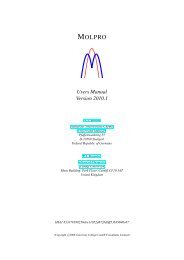Carbon−Carbon Coupling Reactions Catalyzed by Heterogeneous ...
Carbon−Carbon Coupling Reactions Catalyzed by Heterogeneous ...
Carbon−Carbon Coupling Reactions Catalyzed by Heterogeneous ...
Create successful ePaper yourself
Turn your PDF publications into a flip-book with our unique Google optimized e-Paper software.
<strong>Heterogeneous</strong> Pd <strong>Catalyzed</strong> C−C <strong>Coupling</strong> <strong>Reactions</strong> Chemical Reviews, 2007, Vol. 107, No. 1 141<br />
Table 11. Pd/C-<strong>Catalyzed</strong> Suzuki <strong>Coupling</strong> of<br />
2-Iodocycloalkenones with Arylboronic Acids 101<br />
a Isolated yields.<br />
Pd/C-catalyzed coupling of iodoarenes with methoxyphenylboronic<br />
acids in methanol/water using KF as the base gave<br />
high yields of the diaryl 42 under ultrasound irradiation<br />
(Scheme 8). 70<br />
In the bromo- and iodoarene series, the simultaneous use<br />
of high-intensity ultrasound and microwave irradiation<br />
Table 12. Pd/C-<strong>Catalyzed</strong> Suzuki <strong>Coupling</strong> of Aryl Halides with<br />
Arylboronic Acids in 0.1 M aq CTAB<br />
entry Ar1 X Ar2T (°C) t (h) yield (%)<br />
1 4-MeO-Ph I Ph RT 24 95<br />
2 4-MeO-Ph Br Ph RT 24 94<br />
3 4-MeO-Ph Br 4-Me-Ph RT 24 96<br />
4 4-MeO-Ph Br 4-F RT 24 89<br />
5 4-MeO-Ph Br 3-OMe RT 24 65<br />
6 5-pyrimidyl Br Ph RT 24 65<br />
7 4-CHO-Ph Br Ph RT 24 74<br />
8<br />
9<br />
2-NO2-Ph<br />
2-Ac-Ph<br />
Br<br />
Br<br />
Ph<br />
Ph<br />
60<br />
60<br />
24<br />
4<br />
95<br />
89<br />
10 4-Ac-Ph Cl Ph 100 24 85<br />
11<br />
12<br />
2-NH2-4-CF3-Ph<br />
4-MeO-Ph<br />
Cl<br />
Cl<br />
Ph<br />
Ph<br />
100<br />
100<br />
24<br />
24<br />
96<br />
6<br />
Table 13. Pd/C-<strong>Catalyzed</strong> Suzuki <strong>Coupling</strong> of Pyridyl Halides in<br />
Aqueous TBAB<br />
pyridyl halide<br />
TBAB<br />
(equiv)<br />
sometimes gave better results in ligand-free Pd/C-catalyzed<br />
Suzuki cross-coupling reactions than just using one of these<br />
effects (Table 16). 105<br />
2.2. Palladium on Metal Oxides<br />
yield a<br />
(%)<br />
R ) H, X ) 2-Br 0 21<br />
0.1 67<br />
R ) H, X ) 3-Br 0 54<br />
0.1 85<br />
R ) H, X ) 4-Br b 0 55<br />
0.3 67<br />
1.5 95<br />
R ) 3-NO2,X) 2-Cl 0 49<br />
0.1 67<br />
0.3 87<br />
R ) 5-CN, X ) 2-Cl 0 34<br />
1.5 69<br />
a Isolated yields. b Pyridinium hydrochloride was used.<br />
Table 14. Suzuki Cross-<strong>Coupling</strong> of Aryl Chlorides in aq TBAB<br />
R Pd (%)<br />
base,<br />
equiv<br />
PhB(OH)2<br />
(equiv)<br />
T (°C),<br />
t (h)<br />
yield a<br />
(%)<br />
4-Ac 0.2 NaOH, 2.5 1.1 100, 2 99<br />
4-CN 0.5 KF, 2.5 1.1 100, 3 98<br />
2-CN 0.5 KF, 2.5 1.1 140, 3 89<br />
4-CO2Me 0.5 KF, 2.5 1.1 140, 3 87<br />
H 0.5 KF, 2.5 1.1 140, 6 73 b<br />
4-Me 2 NaOH, 5 1.5 140, 6 81<br />
2-Me 2 NaOH, 5 1.5 140, 6 74<br />
4-OMe 2 NaOH, 5 1.5 140, 6 83<br />
4-NH2 2 NaOH, 5 1.5 140, 6 66 c<br />
a Isolated yield; reaction conditions, 4 mmol of ArCl in 6 mL of<br />
water. b 4-Tolylboronic acid was used. c Determined <strong>by</strong> 1 H NMR.<br />
2.2.1. Palladium-Doped KF/Al2O3<br />
Palladium-doped KF/Al2O3 was used in solvent-free Suzuki<br />
couplings. A series of bases, organohalides 44, and<br />
boronic acids 45 were investigated. 106 KF turned out to be












![Hetero [6+3] Cycloaddition of Fulvenes with N-Alkylidene Glycine ...](https://img.yumpu.com/35423358/1/190x245/hetero-6-3-cycloaddition-of-fulvenes-with-n-alkylidene-glycine-.jpg?quality=85)




